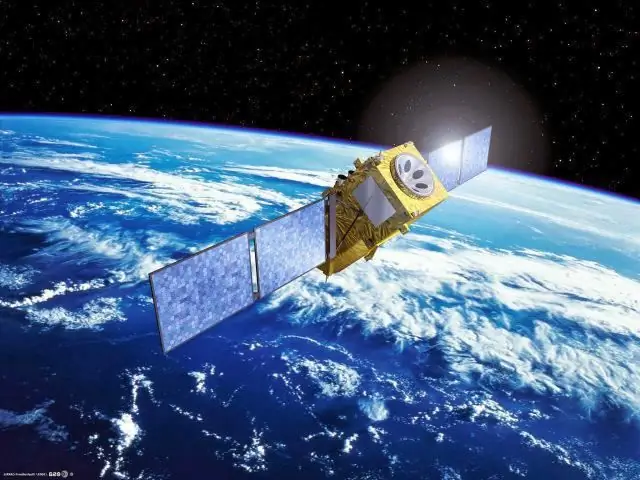2025 Author: Howard Calhoun | [email protected]. Last modified: 2025-01-24 13:10:31
The way to connect and access the Internet through a satellite dish is gaining momentum in our country. Many companies providing satellite television reception also offer Internet via satellite connection as an accompanying or additional service. Such popularity is quite understandable: this "variety" of the Internet has a number of advantages that we are increasingly beginning to appreciate.
What exactly are we talking about?
Considering the advantages of such an Internet, we first of all talk about its availability. Communication using a "dish" can be easily organized at any point related to the satellite coverage area. That is, you can have satellite Internet at home even where there is no way to run a cable or telephone line.
Another significant plus of such a connection is the high speed at which data is transferred, combined with a fairly reasonable price per unit of traffic.

The main problem here is only one - to transfer reverse data fromuser, satellite Internet requires a separate channel - terrestrial (if we are not talking about a two-way option). As a rule, such transmission is carried out using ADSL, GPRS or dial-up technologies.
Perhaps, the disadvantages should be added to the dependence on the weather and the possibility of signal delay. But if there are no other options, the Internet through a satellite dish becomes indispensable. After all, today it is simply vital for many people. For example, satellite Internet in a private house located "far from civilization" will have to be carried out one way or another, if without the Network you cannot imagine a full life.
What equipment do you need
If you decide to bring satellite Internet to a private house, you will need to purchase, in addition to the dish itself, also a cable for it, as well as a DVB-receiver, a computer DVB-card. And don't forget the converter and mounting bracket.
In addition, stock up on F-connectors - they are used to connect cables to converters. If you plan to install and connect the dish yourself, do not forget about the heat shrink, which is needed to insulate the cable with the F-connector, and also stock up the mounting anchors for the bracket.
Setting up the connection
So, we begin to equip satellite Internet with our own hands. The DVB receiver needs a properly tuned satellite. First of all, you need to set up a terrestrial channel according to the requirements of the provider and the technical features of the connection. For insertion, you can use any of the free slots on the computer, after whichthe necessary drivers are installed, which are available on the installation disk sold in the kit.

How to properly configure the driver you installed from the disk, you will learn from the attached instructions. Your task is only to carefully follow it step by step. After installing the drivers, we create a network connection. It is advisable to download the GlobaX program from the network. If you have problems with this item, please contact the place where you bought the satellite equipment.
It would seem that connecting and setting up satellite Internet with your own hands is very difficult. But in fact, following the instructions included in the kit, you can do everything quite sensibly and quickly. In addition, many vendors of such Internet equipment now offer installation and full configuration services. This condition should be clarified when making a purchase.
We mount satellite Internet with our own hands: a sequence of actions
Most individual users are only familiar with one-way Internet access via a satellite dish (also called asynchronous or asymmetric). To have full access, you need to organize a "terrestrial" line (it is needed so that you can transmit the outgoing signal), and for the incoming signal you will need to establish a connection between the dish and the satellite. And connecting satellite Internet with your own hands is a very real task.
Having acquired an offset antenna, a converter, a cable and a DVB network card, let's get down to business. At the first stage, you will need to use any of the types of communicationto connect to the World Wide Web. This can be done using 3G, GPRS or Dial-up modems, as well as using a dedicated DSL line (if any).
Collecting data
When you go online, find as much information as possible about providers that offer internet through a satellite dish. You will have to study and systematize for yourself the names and locations of the satellites they use, compare transponder parameters and refine maps of the area covered by the signal. Be sure to check if your address is in the zone where the signal is caught.

As a result of this information research, you have in your hands a list of providers suitable for those living specifically in your area, with all the conditions and technical characteristics. From here you can already choose one person.
Do not forget that for high-quality satellite signal reception, the antenna should not be blocked by any obstacles in the form of houses or trees.
Final decision
To find out if it is possible for you to receive a signal from the selected satellite, install the Satellite Antenna Alignment program (it's free). The coordinates of the satellite itself are entered into it, then yours - houses and settlements. The program will calculate the location of the satellite relative to your point - the angle of elevation, azimuth, etc. Use these data to check the presence or absence of obstacles again.
If you are able to receive a signal from different providers,the final choice should be made by comparing their rates.
In addition, the required antenna diameter is important - this parameter is contained in coverage maps, as well as the type of convector (C or Ku bands), it depends on the signal frequency. When buying a network card, do not be too lazy to compare the characteristics of all commercially available options to choose the most suitable one.
Put the antenna and check the signal
At the next stage, we proceed to the installation of equipment. Having de alt with this, we insert a network card into the computer slot and install its software. Having picked up a suitable place (so that the selected satellite is available), we install the antenna there. Then we fix the convector on it and connect it to the network card via a cable.

The next step should be to check the satellite signal. The network card tuner program provides for the input of its parameters - frequency, speed, polarization and FEC (information redundancy factor). The antenna must be oriented exactly in the direction of the satellite, this is done using the same free program.
If everything is done correctly, the tuner of the network card should fix the signal from the satellite. How exactly to work with a specific tuner program is indicated in the user manual for the network card.
Completion of procedure
After receiving a signal, you can go to the website of the provider of this satellite, register as a client and subscribe. At your disposal will be a personal account with all the necessarytechnical information - IP addresses, options for connection types, payment methods, etc. By choosing the option that suits you and paying for the service, you can enjoy access to the World Wide Web using satellite.
Practical note: when choosing a satellite, look at what it broadcasts from television programs. The best choice would be to get the Internet and TV "in one bottle".
About "Tricolor" antennas
Many people are wondering if it is now possible to connect satellite Internet through Tricolor and how to do it. Unfortunately, at the moment this is not possible. Services provided under the Tricolor-Internet brand are no longer being operated - since March 2012 their provision has been suspended.

The management of the company explained this by the small number of subscribers using this service (only about 0.1% of the total).
Possibly, in the future, this decision will be canceled, as the company announced its intention to completely revise the strategy. A variant of two-way Internet via satellite is possible. Previously used equipment was distributed to provide services demanded by customers.
Arranging two-way satellite internet
If you want to do away with telephone lines and fiber forever, then you need to start providing a two-way type of satellite communication (two-way). This connection is symmetrical and based on forward and reverse signal transmission.exclusively via satellite.
In this case, the antenna should be purchased Ku-band and having a diameter of 1, 2-1, 8 meters, while with a receiving LNB unit and a transmitting BUC. There are no other hardware restrictions.
It may seem to someone that equipping two-way satellite Internet with your own hands is too difficult a task. It's actually quite simple.

We fix and orient the antenna
The antenna is assembled strictly according to the attached instructions. The place for fastening must be prepared in advance. It is important to determine which position of the antenna will be correct. It depends on the angle of the terrain, the direction in which the satellite is located, the distance to the existing obstacles and the load created by the wind on its mirror.
To do this before attaching, use some other satellite system (eg TV).
With the help of the smwlink program you installed, the antenna is oriented to the south. Having fixed the plate vertically, we connect the speaker with the sound card.
A program that allows you to determine the signal level - Fast Sat Finder. With its help, by rotating the antenna, find and fix its maximum level.
Setup and testing
Then connect your computer (laptop) and install the necessary programs and drivers.
If you are going to connect to the satellite using a desktop computer, you will need to buy and install a DVB-card. For a laptop, you should get an externalDVB device.

Tuning the antenna, test it with a computer. This process is quite long and laborious. Even if there is no interference on the screen, this is not a guarantee of high-quality data transfer. Achieving stability in your network is not so easy.
After setting up the antenna, start connecting to the provider. The procedure in this case is completely similar to that described above - go to the site of the selected provider, submit an application, pay.
Results
Thus, we see that connecting two-way satellite Internet in terms of equipment is not much more difficult than the so-called one-way - one-way (using an amplifier-converter). But the disadvantage of the latter is a lower speed compared to a symmetrical connection.
Of course, it is quite possible to install and configure any equipment by professionals, but there are also disadvantages here. We are not talking about additional costs. But sometimes you will not always be able to understand the quality of the services provided, and many of these tuners work with the help of just a household receiver, which guarantees almost nothing.
Many people, not at all specialists, quite successfully set up two-way satellite Internet with their own hands and never regret it later. So the choice is yours.
Recommended:
How to pay for electricity via the Internet? Payment for electricity on a personal account via the Internet

After the Internet has firmly and closely merged into Russian reality, online financial transactions have ceased to be a unique product for an ordinary person. Online payment operations, even for an inexperienced PC user, are quite simple. In this article you can find detailed instructions on how you can pay for electricity using the Internet
How to pay for the Internet through a Sberbank card via the Internet, via phone?

The modern world has long been impossible to imagine without the Internet, it is no longer a luxury, but an indispensable assistant to a person, both in work and in personal life. But the services of an Internet provider are not free, you need to pay for them every month, and this procedure takes time, which a modern person has very little. Sberbank always thinks about the convenience of its customers and makes it possible to pay for the Internet through a Sberbank card
Internet in the village: the best options. Satellite Internet

In the modern world, people cannot imagine life without the Internet. And someone decides to move closer to nature, but continue to enjoy the benefits of civilization. What is the best internet in the countryside? The best options will be discussed in this article
Satellite Internet - reviews. Satellite Internet - providers. Tariffs

Can satellite internet be considered a competitor to fiber optics, fast mobile internet and broadband access lines? Expert opinions differ, but this segment of the market has not yet reached the limits of growth
"Two times two" - a residential complex (Krasnoye Selo): description, layout and reviews

Residential Complex "Twice Two" (Krasnoye Selo) - comfortable affordable apartments for modern people. What is the peculiarity of this complex and what should you pay attention to?

